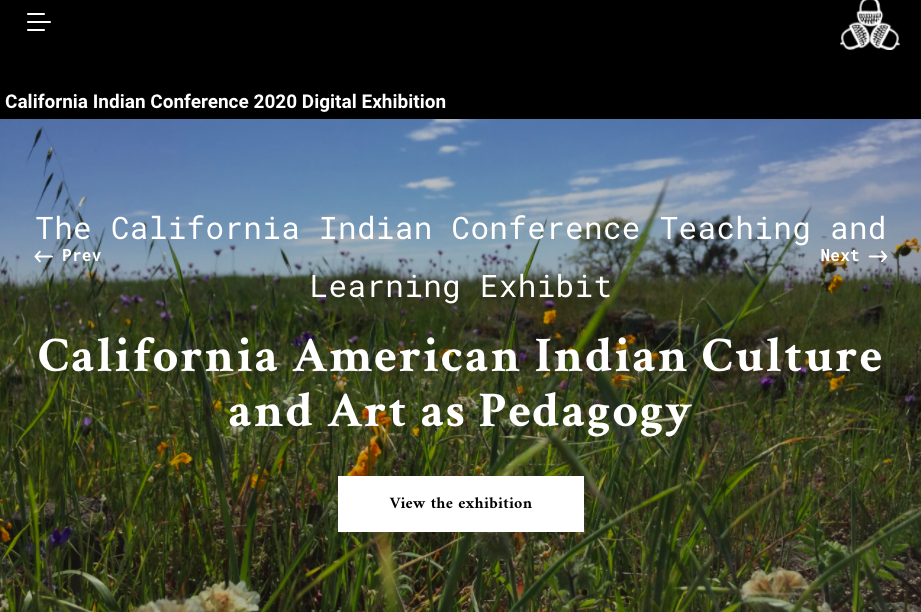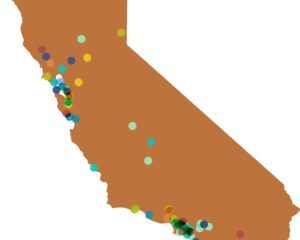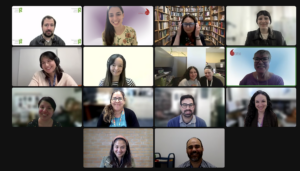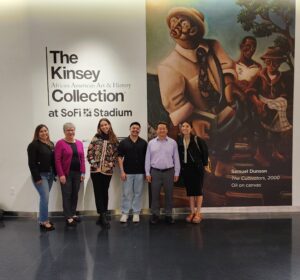“California’s land and water systems are the homelands to over 109 federally recognized tribes and many others that hold cultural-intellectual knowledge and California’s history, despite large scale efforts to deracinate California of its indigenous peoples. Over twenty American Indian tribes steward the Central Valley homelands.” – Exhibition Co-Creators
California Humanities recognizes the strong interconnections between the arts and humanities; we believe these explorations across disciplines bring vitality and innovation to the public humanities. Since 2018, the Humanities for All Quick Grant program has supported 80 arts and humanities projects that have blended these disciplines to interpret, analyze, and contribute a greater understanding of California’s rich cultural life.
As this list of impactful public humanities projects continues to grow, this National Arts & Humanities Month, we interview project director Leece Lee-Oliver about the exhibition “California American Indian Culture and Art as Pedagogy: A Teaching and Learning Exhibit.” A recent Humanities for All Quick Grant recipient, this virtual resource and exhibition that centers on indigenous ecology and systems of knowledge are organized by Dr. Leece Lee-Oliver, Assistant Professor and Director of American Indian Studies at Fresno State, in collaboration with co-curators Elena Harvey Collins, M.A., Cristina Gonzales, M.A., and Carly Tex, M.A. The organizers of this project are members of a collective of American Indian and Central Valley cultural practitioners, artists, producers, and scholars who are guided by a commitment to celebrate the cultural-intellectual traditions of California American Indian societies and peoples.
Tell us about the inspiration behind your project: American Indian Culture and Art as Pedagogy: A Teaching and Learning Exhibit?
I came into the exhibition project as a director as part of my role as the Chair of the California Indian Conference organizing committee. I had mostly made a commitment to focus my time and energy on the daily operations of the conference and planning, but I wanted to contribute somehow to the content. I had recently lost my mom, a social justice activist, a highly accomplished artist, and a poet. Throughout her life, she was adept at integrating teaching, learning, and self-reflexive work with art to grow awareness and protect of all living creatures on the earth. She was a lifelong learner and teacher who was a tireless pupil of the living universe. I learned the importance of developing creativity, imagination, and relationships with the living universe; forming this foundational relationship is paramount to forming a relationship with our ultimate teacher and is healing mentally, spiritually, and physically. When I had the opportunity to contribute something meaningful to the conference, I was inspired by her memory to celebrate California’s wonderful culture bearers, Elders, youth, and the indigenous praxes of intergenerational knowledge sharing; and to create space where they could share their wisdom about the living universe and the interconnections between cultural-intellectual-spiritual, scientific, and pedagogical traditions. These, inextricably linked with ethos bound by respect, love, and reciprocity also engage learnings in healing and decolonial processes that grows our understanding of living in reciprocity with the living universe and the challenges we face with our current ecological crises.
This exhibition also allowed me to engage in a collaborative endeavor with the curators and the contributors, mirroring the community-building praxes of my youth and young adult life as the daughter of a social justice and American Indian urban community.
Can you highlight a few of the artists who are featured in this exhibition?
Each culture bearer tells the story of California American Indian peoples through a loving relationship to place, history, today, and each embarks on a journey that helps visitors think about themselves in places and time. The traditions that appear in their work, the love and wisdom they carry, are richly informed by California American Indian cultural-intellectual and spiritual values. Each provides multiple entry points for building pedagogy and for learning from each other. Cristina Gonzales shows her love of the work, the process and practices of gathering, and the practice of intergenerational knowledge sharing. Carly Tex lets us see into the culture bearer’s knowledge of the ecological life systems and the meditative steps taken to learn and build relationships that become the basis of her teaching and weaving. Pomo culture bearer, Corine Pearce, demonstrates the absolute commitment to excellence as a master weaver and yet shares what her enduring work is, also alerting her to changes in our shared climate and the wisdom in American Indian epistemologies that hold healing solutions for our earth and ourselves.
Linda Yamane’s extraordinary works connect us with the relationships between language, cultural materials, land, and water that simultaneously necessitate a relationship to one’s indigenous self and people. Lyn Risling shares the inspiration and responsibilities we share across generations that inextricably connect us to the living universe through ceremony. Heidi Lucero’s complex praxes are shared through her revitalization of traditional handpoke tattooing, which is masterfully used to reclaim cultural foods, art, and praxes. Her generosity is exemplative of the intertribal relationality. Artist Shonna Alexander takes upon herself the deeply historical artistic practice of ledger painting. Carrying on a method of art/voice, ledger painting serves as artistic expression, cultural knowledge production, and knowledge preservation.
What advice would you share with project directors who are thinking of developing arts and humanities projects?
At the heart of arts and humanities projects are inspiration and curiosity. If I have any recommendations at all, it is to find one piece of your inspiration and examine its different components and modalities and use that “tell story.” Our exhibition is a complex set of storytelling and storytellers, from the curators to the culture bearers. Also, let the people speak for themselves. We worked in earnest to create spaces for the culture bearers and artists to express themselves. We continue to share this exhibition widely to inspire others to harness the wonderful educational opportunities we found in collectively venturing to produce something akin to myriad voices. There is no authoritative speculation here. We make space and make story together. I followed my intuition and sought out curatorial partners to collaborate with, which proved invaluable. Trust your instincts. We cultivated a set of questions that we felt meaningfully aligned with our broad goals and provided very light editing to fit story texts within the site. The result is a rich tapestry of voices and perspectives, lessons, and gifts that invite readers, viewers, creative workers, and educators to dwell, contemplate, learn and create.
As an educator, I felt that it was important that the exhibit include research resources for educators. I am, in my work and this exhibition, motivated to overturn stereotypes with knowledge. For educators who spend time with us on our site, I wanted them to have opportunities to grow curricula that offer them and their students opportunities to learn and develop new understandings about California American Indian peoples, historically and today. Embark on creative ventures and look for different elements of life expression that you can bring together. Trust the stories, work, and project to come together and work to respond to what becomes.
______________________________________________________________________________
The exhibition co-creators invite you to view the California American Indian Culture and Art As Pedagogy exhibit here.





